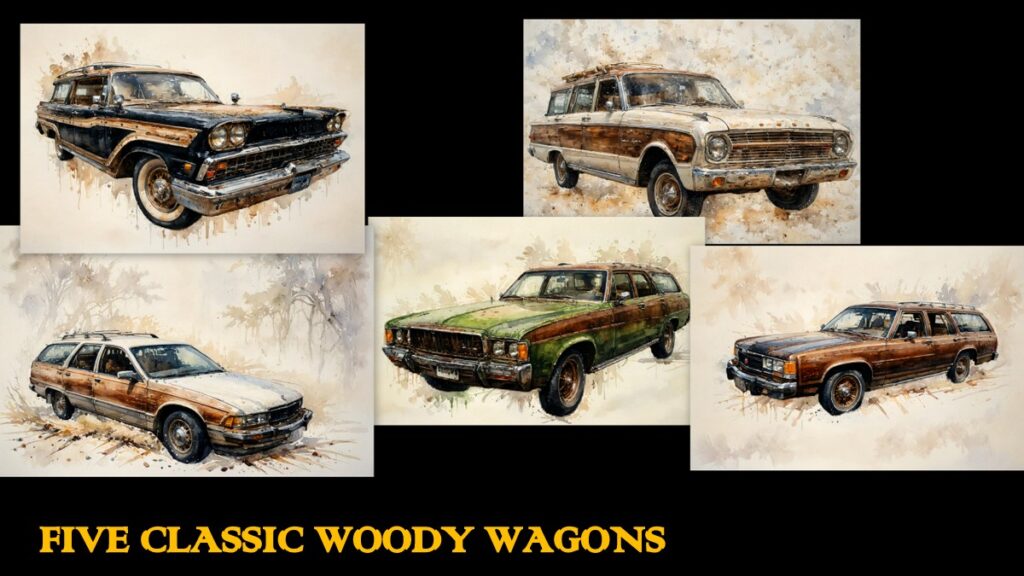Woody wagons got their nickname from their wood body frames because that’s how they built cars and trucks back then.
The woody wagon tradition continued for decades, so here are five of them ranging from the 1950s to the 1990s.
Jerry Sutherland
The first example of a classic woody is the 1959 Mercury Colony Park wagon.
This big wagon marked the last year for massive doses of chrome and stainless steel over large percentages of sheet metal. In other words, it was 1959.
These Mercs came with a 383 cubic inch Marauder engine that pumped out 322-horsepower. That was enough to push this 4500-pound tugboat up to 1950s turnpike speed with ease.
You could option these monsters right up to Lincoln standards—even air conditioning. The Colony Park wagons are perfect examples of late-50s Space Age styling madness—the ’59 was a slightly-muted version of the 1957-58 Mercs.
The second example of a classic woody wagon is the 1962 Ford Falcon Squire. This car represents a huge departure from its older cousin–the ’59 Merc wagon.
There’s a simple reason for this. VW Beetles were taking no prisoners in the economy compact car class, so the Big Three offered competitors in that class.
The Falcon was Ford’s answer, and this wagon was an upscale version of that name. The Squire was the top shelf of the Falcon name, and it could be ordered with an optional 170-cubic-inch inline 6 that pumped out 101 horsepower—a big step up on the 85-horse 144-cubic-inch version. Most buyers of this high-end Falcon coughed up extra cash for the bigger six.
The third classic woody is the ’71 AMC Ambassador Brougham. These were medium-sized wagons in a world where land yachts like Chrysler C-Body wagons ruled the road.
The Ambassador Brougham was a great example of 70s tech because it came with a few options for V-8 engines ranging from 304 cubic inch; to 360 cubic inches; to a big, bad 401 cubic inch option.
The SST option pushed the 401 up to a very respectable 330-horsepower. That was definitely enough power to dominate the 70s era soccer mom road races. The Ambassador Brougham wagon was an overlooked choice in the long roof sweepstakes back in ’71, but that didn’t mean it was an inferior choice. It simply meant Ford, GM and Chrysler buyers were brand loyal.
The fourth example is the 1989 Ford Crown Victoria Country Squire wagon. This was the latest incarnation of the classic Country Squire wagon that hauled families for decades.
Ford ran with the bulletproof 302 cubic inch Ford small block and that was a solid bet for buyers during the twilight era for big station wagons. It pumped out 150 horses with single exhaust and 160 with dual exhausts.
That wasn’t rock star performance, but it was adequate for a late 80s wagon, plus the fuel injection turned it into a longer-lasting engine with better mileage. That was an asset when you lived in a world where big wagons were disappearing faster than political promises.
The woody wagon era began when their bodies were really made from wood, but the concept exited with the 1995 Buick Roadmaster.
These cars were built for that thin demographic of upscale guys who needed a wagon with Buick quality and Buick presence with a Buick price tag. They came with LT-1 Vette engines so they could soar with the eagles on the freeway.
They were the last of the big wagons. These Roadmasters are gaining a huge following with Gen X survivors who see cars like this and embrace the Buick as a nostalgic piece of their past.
They were right—the woody wagons were a huge part of many multi-generational memories.
Jerry Sutherland
y: Jerry Sutherland
Jerry Sutherland is a veteran automotive writer with a primary focus on the collector car hobby. His work has been published in many outlets and publications, including the National Post, Calgary Herald, Edmonton Journal, Ottawa Citizen, Montreal Gazette, Saskatoon StarPhoenix, Regina Leader-Post, Vancouver Sun and The Truth About Cars. He is also a regular contributor to Auto Roundup Publications.
- CLICK HERE TO SIGN UP FOR THE NEWSLETTER
- CLICK HERE to Like us on Facebook
- CLICK HERE to Follow us on Twitter
- CLICK HERE to Follow us on Pinterest
